Design, Implementation and Validation of a Hardware-in-the-Loop Test Bench for Heating Systems in Conventional Coaches
Abstract
:1. Introduction
2. Materials and Methods
2.1. Experimental Plant
- -
- Engine emulation: This subsystem consists of a gas boiler heating unit (24 kW) and a buffer tank (100 L), which allows the emulation of the heat produced by the vehicle’s internal combustion engine through its cooling circuit, being able to produce a constant and continuous hot water flow of 12 L/min at 80 °C. A regulated three-way mixing valve was included at the outlet of the tank to control inlet temperature to the HVAC unit and thus reproduce the behaviour of the engine at start-up, emulating the transitory regime until the steady-state operating temperature is reached. In addition, a water hydraulic pump (the same model of 24 VDC installed in coaches) was used to impulse the hot water to the HVAC unit. Furthermore, a three-way proportional manual valve was included to limit the maximum flow entering the HVAC unit, only added for research purposes (to analyse the effect of changing maximum water flow, reduced in new coaches).
- -
- HVAC Unit (Figure 3): This is the main element of the experimental plant. It essentially consists of a water–air heat exchanger, in which heat transfer takes place between the hot water driven by the pump coming from the engine cooling circuit and the outdoor (or recirculated) air. Forced ventilation was carried out by employing two fans, whose speed was varied using Pulse Width Modulation (PWM), to drive the inlet air perpendicularly to the exchanger coil through which the hot water passes. Moreover, this unit had an electric valve to control the inlet hot water flow rate, with this being the main actuator in the temperature or flow (only in the laboratory setting, not in real coaches) control loops. The HVAC unit included two doors whose aperture was controlled by two DC motors; one of these doors was used to control the airflow sent to the vehicle’s front window, intended for dehumidification purposes, for the driver’s feet outputs or a combination of both. The other door was employed to recirculate air from inside the cabin or insert renewal air from outside.
- -
- Outside temperature emulation: An external refrigeration device was used to impose low-temperature air environmental conditions. This subsystem can keep the inlet constant temperature as low as −10 °C. Forced ventilation was used to direct the cold air from the chamber to the HVAC unit.
2.2. Proposed Cabin Thermal Model
2.3. Experimental Data
3. Results and Discussion
3.1. Model Validation
3.2. Hybrid Hardware-in-the-Loop Test-Bench
3.3. Test Experiments
4. Conclusions
Author Contributions
Funding
Institutional Review Board Statement
Informed Consent Statement
Data Availability Statement
Acknowledgments
Conflicts of Interest
Abbreviations/Nomenclature
| surface [m2] | |
| heat capacity [J K−1] | |
| specific heat capacity [J·Kg-1·K-1] | |
| acceleration of gravity [m s−2] | |
| height of the contact area between two zones [m] | |
| solar irradiance [W m−2] | |
| heat load [W] | |
| Temperature [K] | |
| time [s] | |
| overall heat transfer coefficient [W K−1 m−2] | |
| volume [m3] | |
| volumetric flow rate [m3 s−1] | |
| absorptivity [-] | |
| ratio of airflow rate from recirculation [-] | |
| density [J·Kg−1·K−1] | |
| Subscripts | |
| 1 | zone 1 (driver) |
| 2 | zone 2 (passengers) |
| H | heating system |
| i | interior air |
| o | outside air |
| oc | occupants |
| ref | reference |
| sun | solar |
| sup | air supplied |
| w | windows |
References
- De La Cruz, A.T.; Riviere, P.; Marchio, D.; Cauret, O.; Milu, A. Hardware in the Loop Test Bench Using Modelica: A Platform to Test and Improve the Control of Heating Systems. Appl. Energy 2017, 188, 107–120. [Google Scholar] [CrossRef]
- Ma, Z.; Wang, S.; Xiao, F. Online Performance Evaluation of Alternative Control Strategies for Building Cooling Water Systems Prior to in Situ Implementation. Appl. Energy 2009, 86, 712–721. [Google Scholar] [CrossRef]
- Lee, K.Y.; Flynn, D.; Xie, H.; Sun, L. Modelling, Simulation and Control of Thermal Energy Systems; MDPI: Basel, Switzerland, 2021; ISBN 9783039433605. [Google Scholar]
- Ruz, M.L.; Garrido, J.; Vázquez, F.; Morilla, F. A Hybrid Modeling Approach for Steady-State Optimal Operation of Vapor Compression Refrigeration Cycles. Appl. Therm. Eng. 2017, 120, 74–87. [Google Scholar] [CrossRef]
- Pawar, S.; Gade, U.R.; Dixit, A.; Tadigadapa, S.B.; Jaybhay, S. Evaluation of Cabin Comfort in Air Conditioned Buses Using CFD. SAE Tech. Pap. 2014, 1, 699. [Google Scholar] [CrossRef]
- Riachi, Y. A Numerical Model for Simulating Thermal Comfort Prediction in Public Transportation Buses. Int. J. Environ. Prot. Policy 2014, 2, 1–8. [Google Scholar] [CrossRef]
- Gürbüz, H.; Akçay, İ.H.; Asghar, H.; Ali, Q.A. Analysis of Bus Air Conditioning System by Finite Elements Method (ANSYS). Int. J. Automot. Eng. Technol. 2016, 5, 115–124. [Google Scholar] [CrossRef]
- Scurtu, I.L.; Jurco, A.N. Airflow and Thermal Comfort of the Bus Passengers. J. Ind. Des. Eng. Graph. 2019, 14, 171–174. [Google Scholar]
- Zhu, S.; Srebric, J.; Spengler, J.D.; Demokritou, P. An Advanced Numerical Model for the Assessment of Airborne Transmission of Influenza in Bus Microenvironments. Build. Environ. 2012, 47, 67–75. [Google Scholar] [CrossRef]
- Li, F.; Lee, E.S.; Liu, J.; Zhu, Y. Predicting Self-Pollution inside School Buses Using a CFD and Multi-Zone Coupled Model. Atmos. Environ. 2015, 107, 16–23. [Google Scholar] [CrossRef]
- Pirouz, B.; Mazzeo, D.; Palermo, S.A.; Naghib, S.N.; Turco, M.; Piro, P. Cfd Investigation of Vehicle’s Ventilation Systems and Analysis of Ach in Typical Airplanes, Cars, and Buses. Sustainability 2021, 13, 6799. [Google Scholar] [CrossRef]
- Marshall, G.J.; Mahony, C.P.; Rhodes, M.J.; Daniewicz, S.R.; Tsolas, N.; Thompson, S.M. Thermal Management of Vehicle Cabins, External Surfaces, and Onboard Electronics: An Overview. Engineering 2019, 5, 954–969. [Google Scholar] [CrossRef]
- Liebers, M.; Tretsiak, D.; Klement, S.; Bäker, B.; Wiemann, P. Using Air Walls for the Reduction of Open-Door Heat Losses in Buses. SAE Int. J. Commer. Veh. 2017, 10, 423–433. [Google Scholar] [CrossRef]
- Pathak, A.; Binder, M.; Chang, F.; Ongel, A.; Lienkamp, M. Analysis of the Influence of Air Curtain on Reducing the Heat Infiltration and Costs in Urban Electric Buses. Int. J. Automot. Technol. 2020, 21, 147–157. [Google Scholar] [CrossRef]
- Marcos, D.; Pino, F.J.; Bordons, C.; Guerra, J.J. The Development and Validation of a Thermal Model for the Cabin of a Vehicle. Appl. Therm. Eng. 2014, 66, 646–656. [Google Scholar] [CrossRef]
- Schaut, S.; Sawodny, O. Thermal Management for the Cabin of a Battery Electric Vehicle Considering Passengers’ Comfort. IEEE Trans. Control Syst. Technol. 2020, 28, 1476–1492. [Google Scholar] [CrossRef]
- Torregrosa-Jaime, B.; Bjurling, F.; Corberán, J.M.; Di Sciullo, F.; Payá, J. Transient Thermal Model of a Vehicle’s Cabin Validated under Variable Ambient Conditions. Appl. Therm. Eng. 2015, 75, 45–53. [Google Scholar] [CrossRef]
- Kruppok, K.; Claret, F.; Neugebauer, P.; Kriesten, R.; Sax, E. Validation of a 5-Zone-Car-Cabin Model to Predict the Energy Saving Potentials of a Battery Electric Vehicle’s HVAC System. IOP Conf. Ser. Mater. Sci. Eng. 2018, 383, 012037. [Google Scholar] [CrossRef]
- O’Boyle, C.; Douglas, R.; Best, R.; Geron, M. Vehicle Thermal Modelling for Improved Drive Cycle Analysis of a Generic City Bus. Proceeding of the 2020 5th International Conference on Smart and Sustainable Technologies (SpliTech), Split, Croatia, 23–26 September 2020; pp. 3–7. [Google Scholar] [CrossRef]
- Zhang, Y.; Xiong, R.; He, H.; Shen, W. Lithium-Ion Battery Pack State of Charge and State of Energy Estimation Algorithms Using a Hardware-in-The-Loop Validation. IEEE Trans. Power Electron. 2017, 32, 4421–4431. [Google Scholar] [CrossRef]
- Xiong, R.; Tian, J.; Shen, W.; Sun, F. A Novel Fractional Order Model for State of Charge Estimation in Lithium Ion Batteries. IEEE Trans. Veh. Technol. 2019, 68, 4130–4139. [Google Scholar] [CrossRef]
- Yang, B.; Wang, J.; Zhang, X.; Wang, J.; Shu, H.; Li, S.; He, T.; Lan, C.; Yu, T. Applications of Battery/Supercapacitor Hybrid Energy Storage Systems for Electric Vehicles Using Perturbation Observer Based Robust Control. J. Power Sources 2020, 448, 227444. [Google Scholar] [CrossRef]
- Wang, F.X.; Peng, Q.; Zang, X.L.; Xue, Q.F. Adaptive Cruise Control for Intelligent City Bus Based on Vehicle Mass and Road Slope Estimation. Appl. Sci. 2021, 11, 12137. [Google Scholar] [CrossRef]
- El-Baz, W.; Mayerhofer, L.; Tzscheutschler, P.; Wagner, U. Hardware in the Loop Real-Time Simulation for Heating Systems: Model Validation and Dynamics Analysis. Energies 2018, 11, 3159. [Google Scholar] [CrossRef]
- Conti, P.; Bartoli, C.; Franco, A.; Testi, D. Experimental Analysis of an Air Heat Pump for Heating Service Using a “Hardware-in-the-Loop” System. Energies 2020, 13, 4498. [Google Scholar] [CrossRef]
- Jiang, Z.; Cai, J.; Moses, P.S. Smoothing Control of Solar Photovoltaic Generation Using Building Thermal Loads. Appl. Energy 2020, 277, 115523. [Google Scholar] [CrossRef]
- Michalek, D.; Gehsat, C.; Trapp, R.; Bertram, T. Hardware-in-the-Loop-Simulation of a Vehicle Climate Controller with a Combined HVAC and Passenger Compartment Model. IEEE/ASME Int. Conf. Adv. Intell. Mechatron. AIM 2005, 2, 1065–1070. [Google Scholar] [CrossRef]
- González, I.; Calderón, A.J.; Figueiredo, J.; Sousa, J.M.C. A Literature Survey on Open Platform Communications (OPC) Applied to Advanced Industrial Environments. Electronics 2019, 8, 510. [Google Scholar] [CrossRef]
- ASHRAE (American Society of Heating, Refrigerating and Air-Conditioning Engineers). ASHRAE Handbook–Fundamentals, SI ed.; ASHRAE (American Society of Heating, Refrigerating and Air-Conditioning Engineers): Atlanta, GA, USA, 2009. [Google Scholar]
- Rashid, R.M. Thermal Management of Vehicle Interior Temperature for Improvement of Fuel Economy; University of Windsor: Windsor, ON, Canada, 2018. [Google Scholar]
- Yang, D.; Du, T.; Peng, S.; Li, B. A Model for Analysis of Convection Induced by Stack Effect in a Shaft with Warm Airflow Expelled from Adjacent Space. Energy Build. 2013, 62, 107–115. [Google Scholar] [CrossRef]
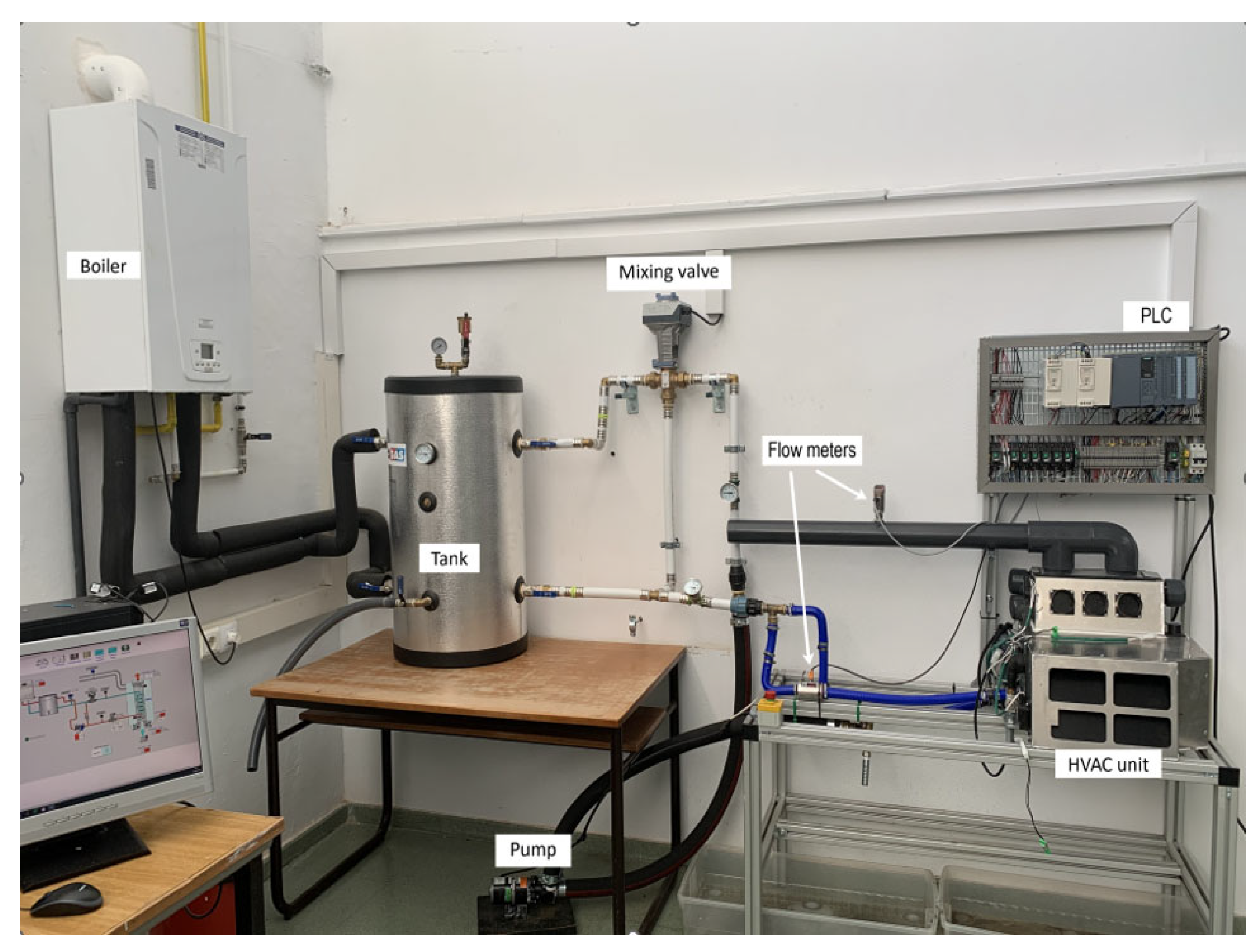
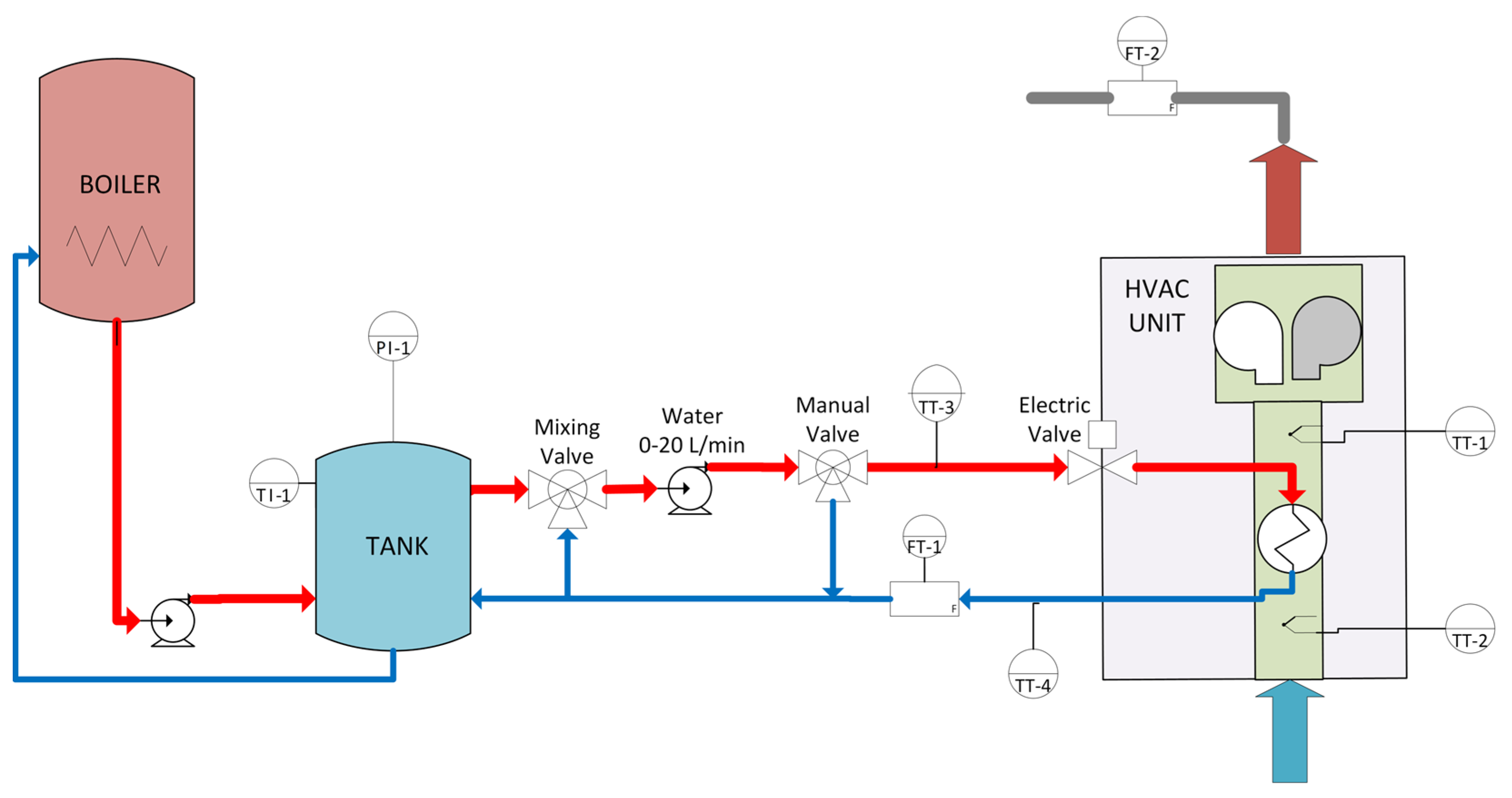
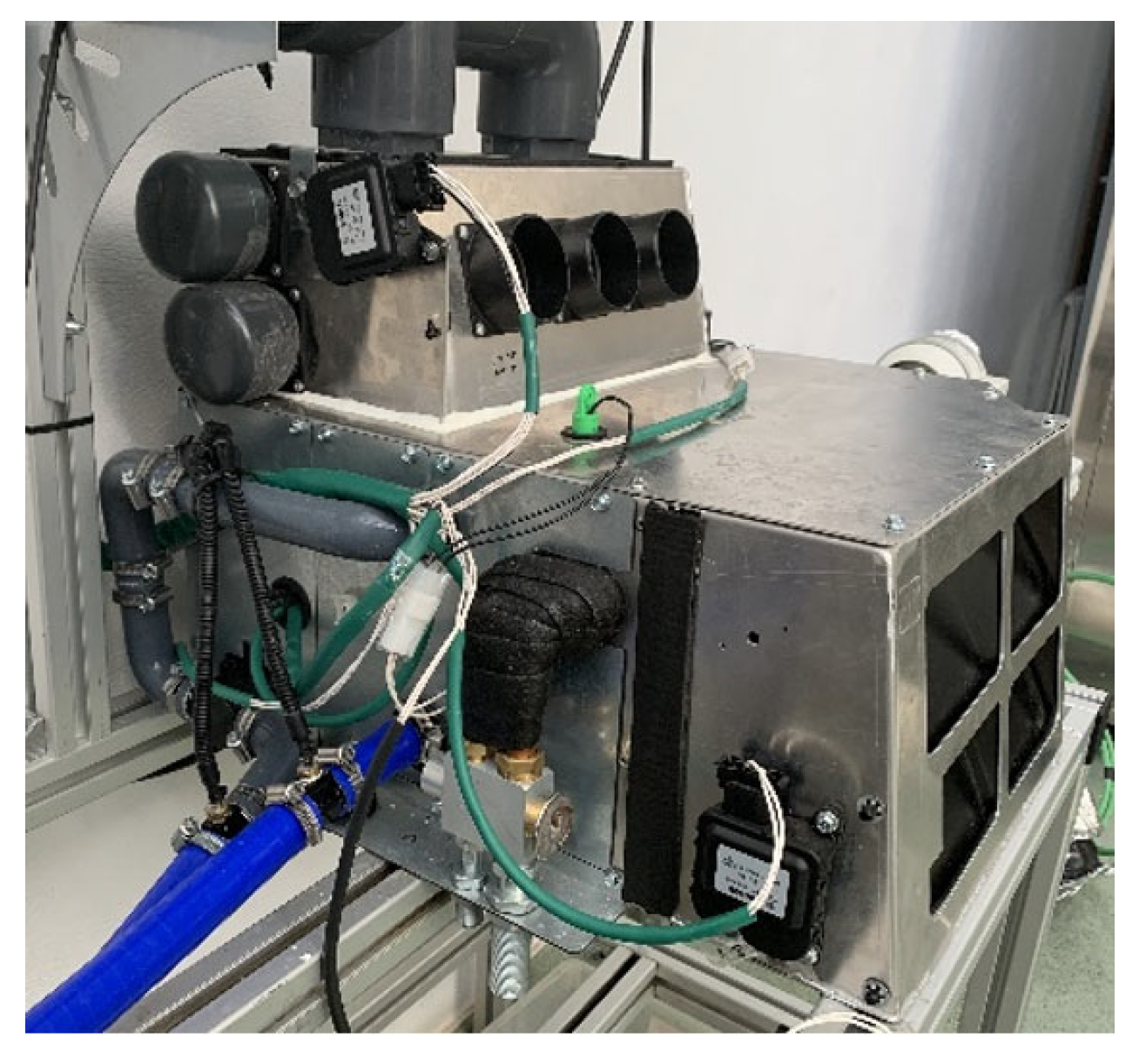
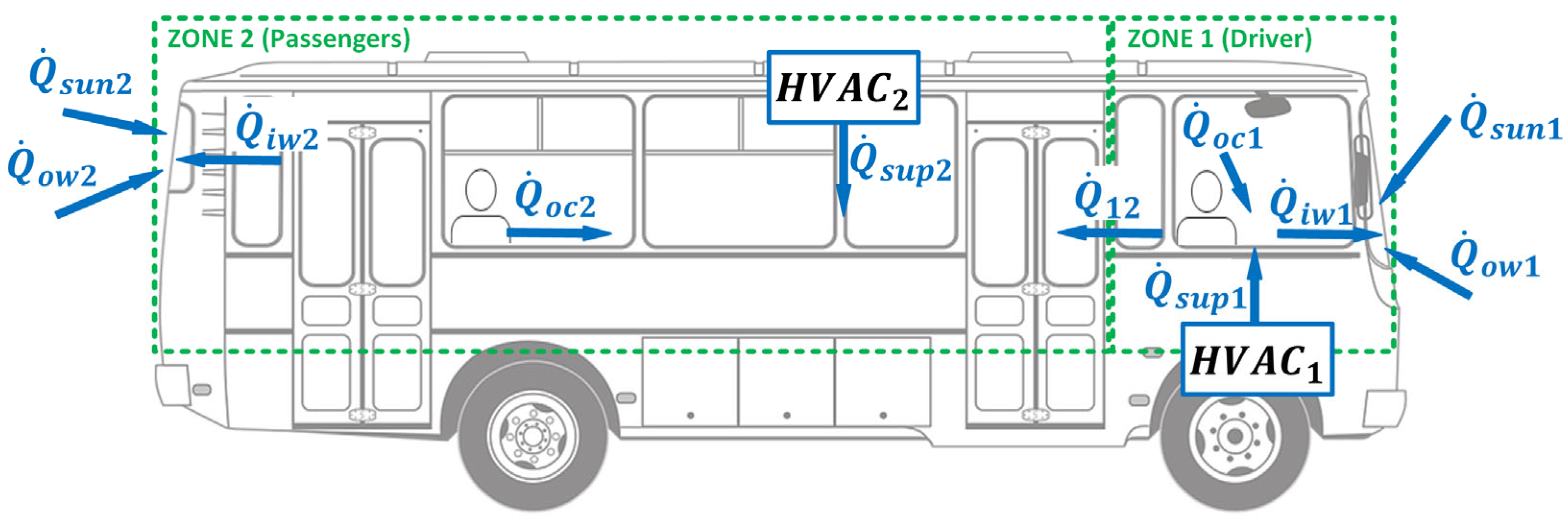
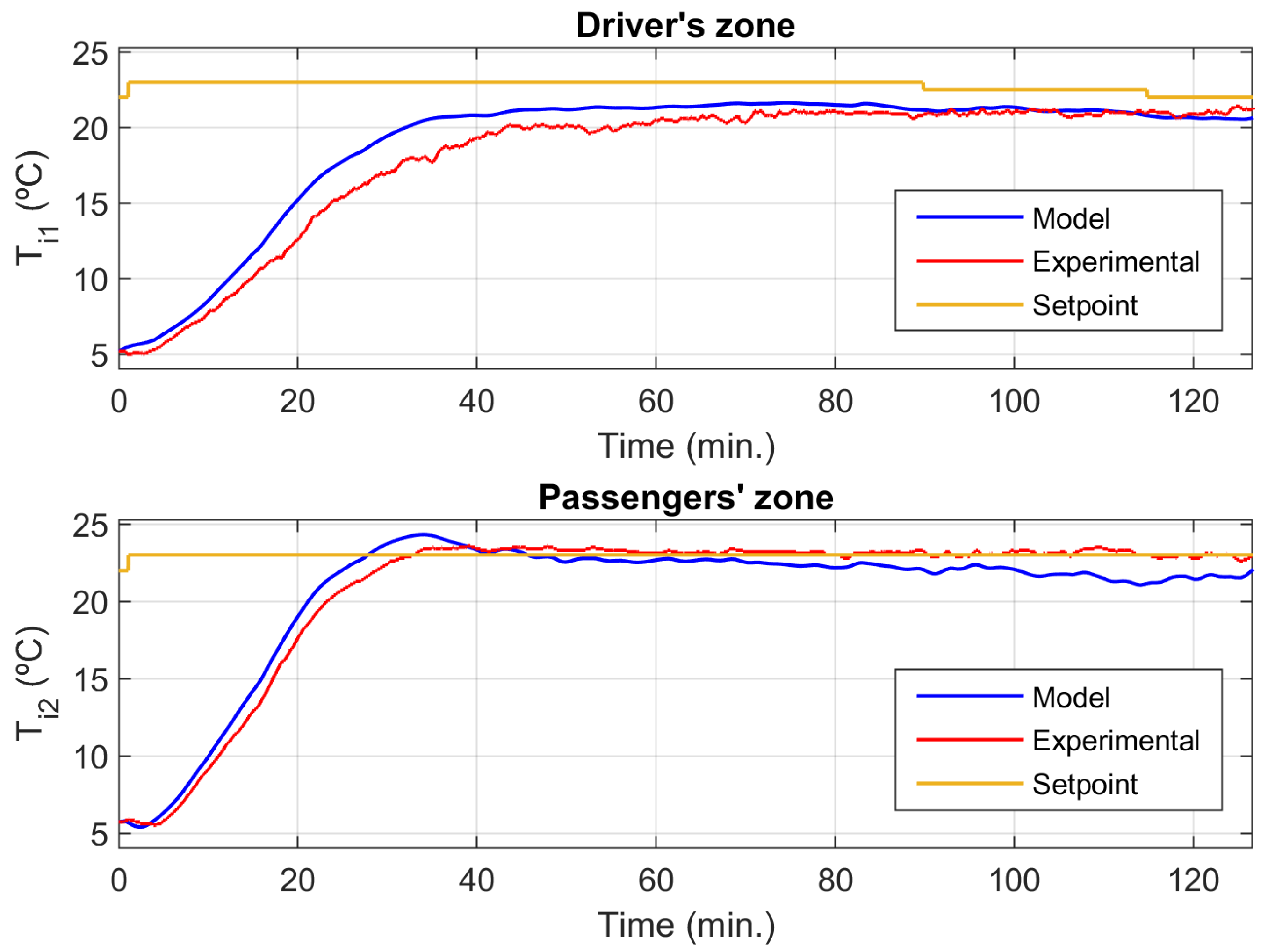
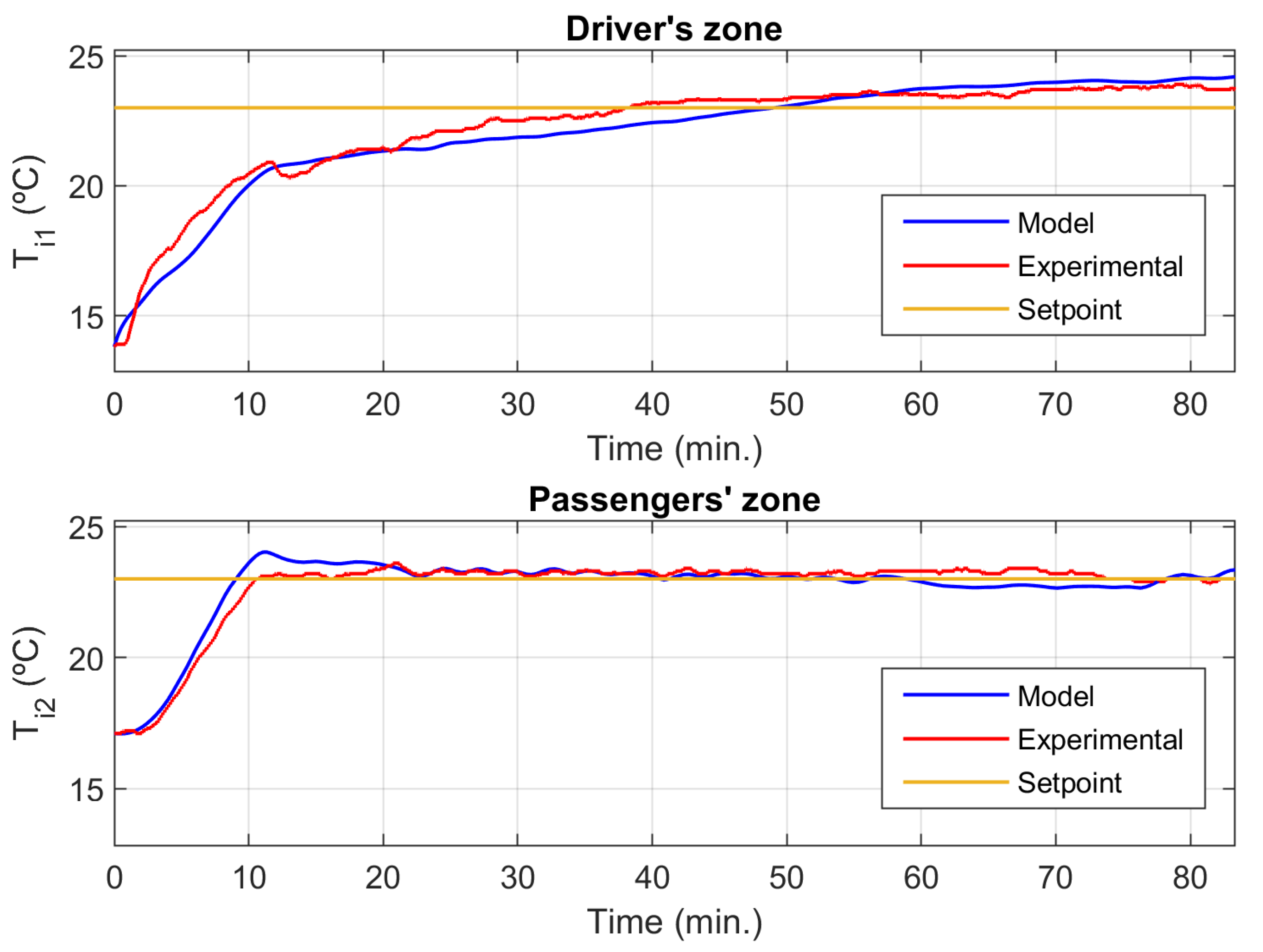


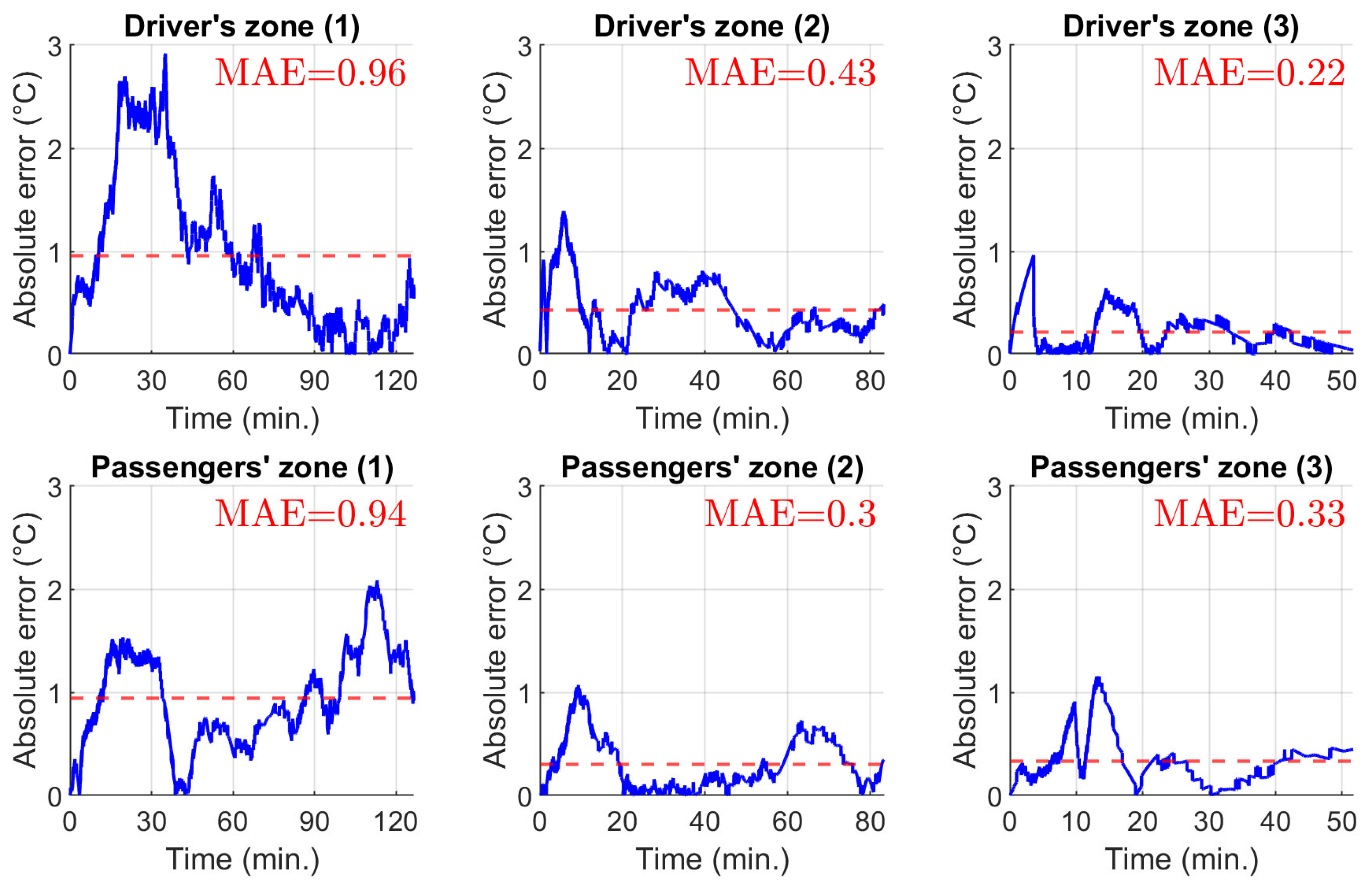
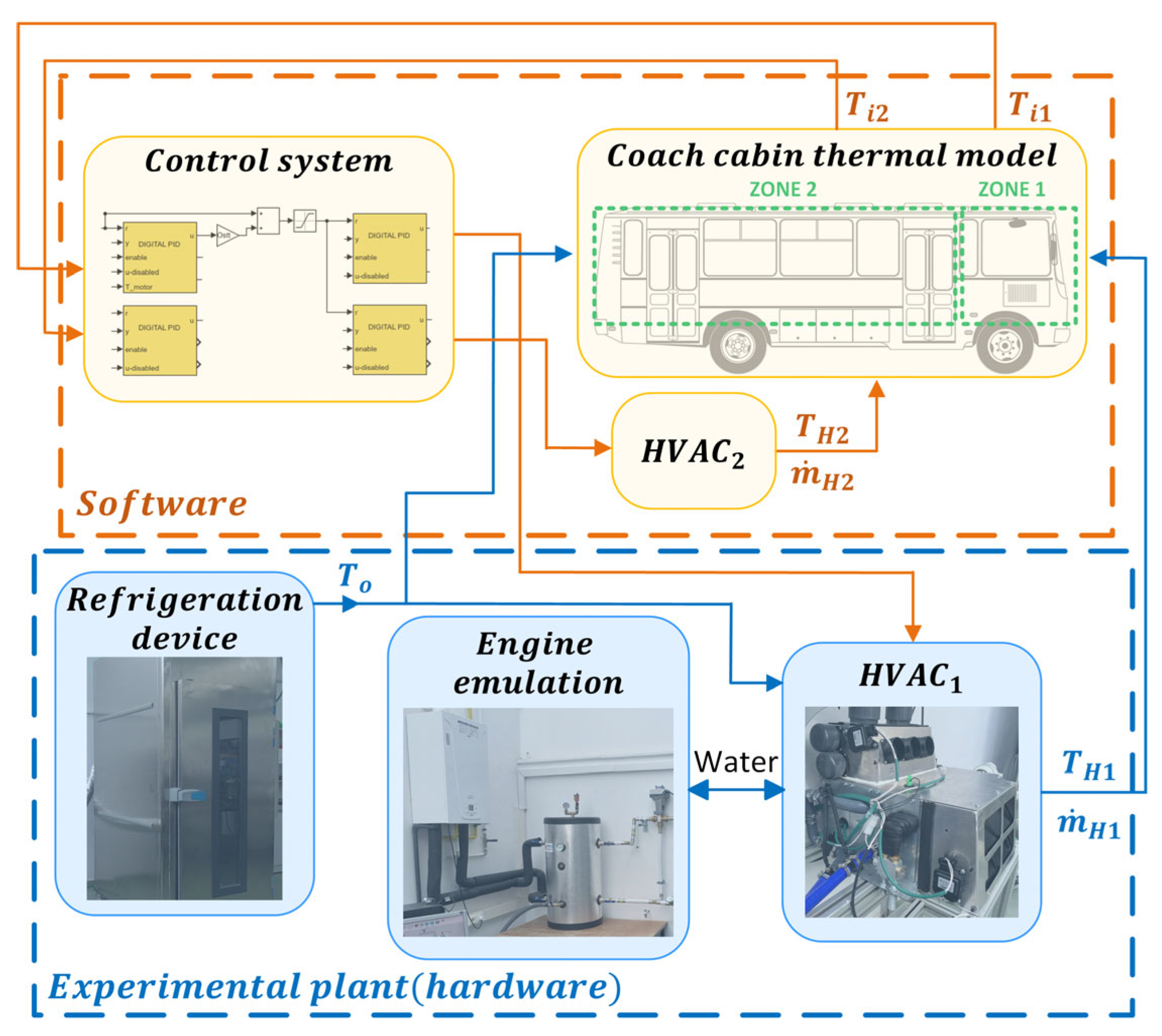

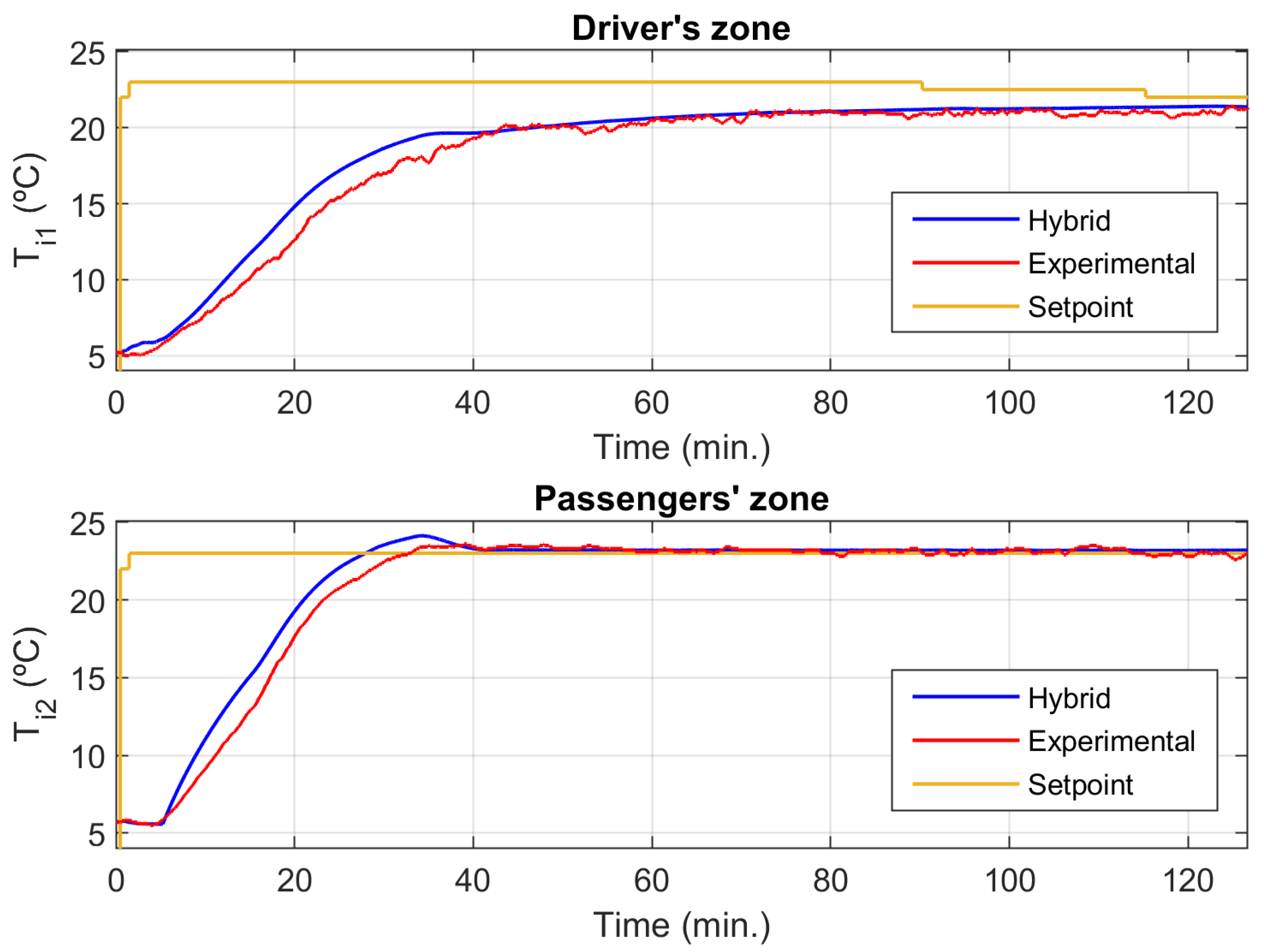
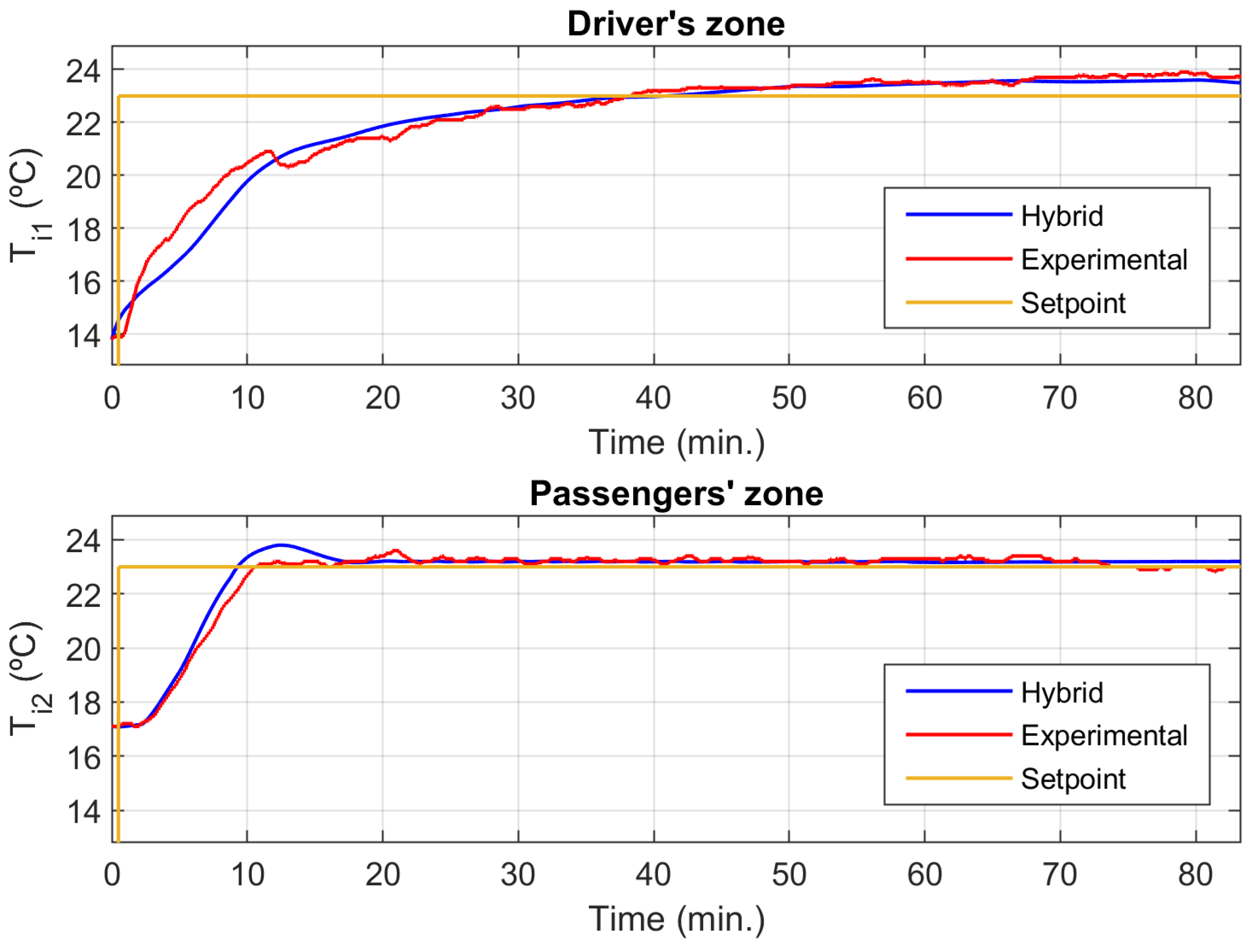
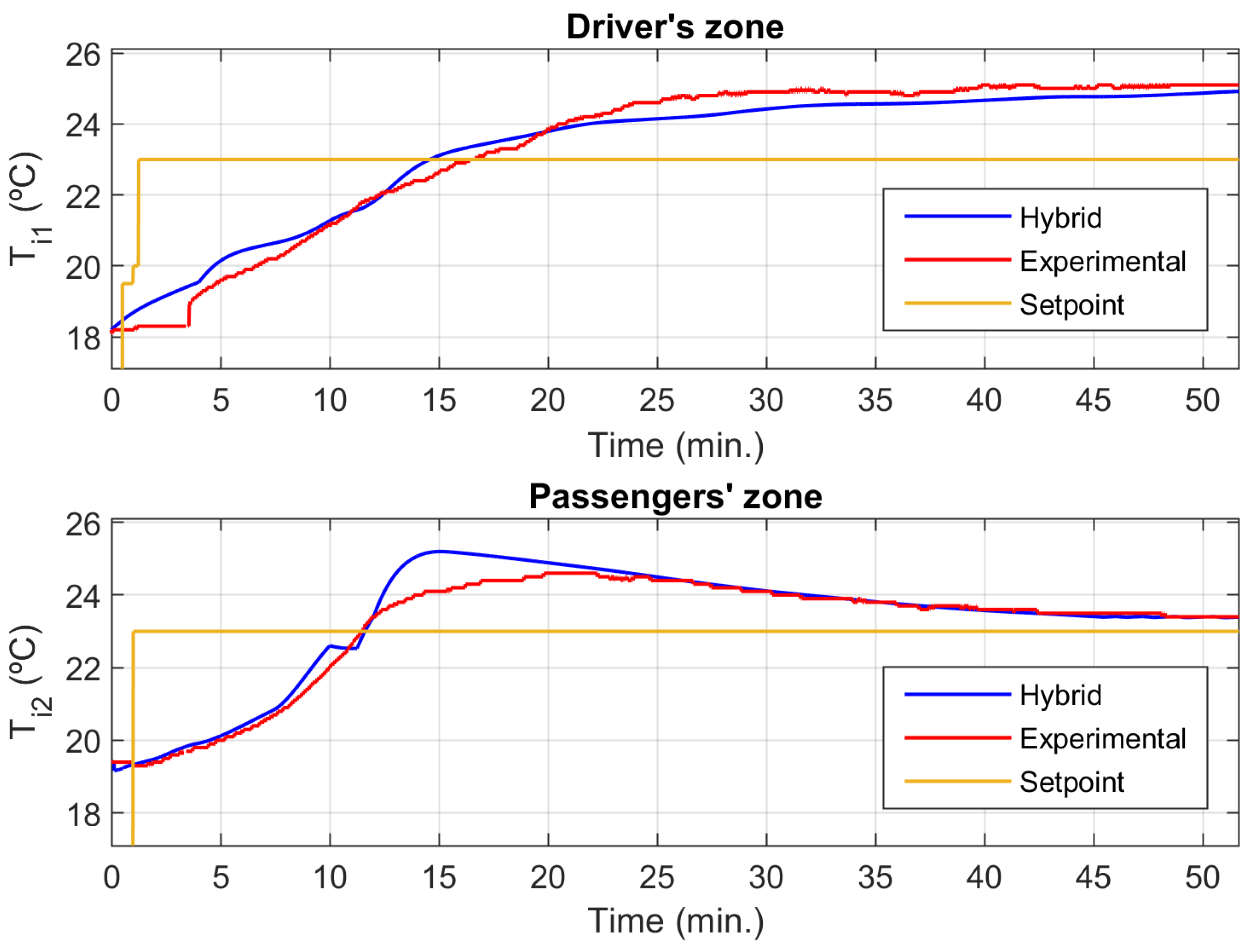

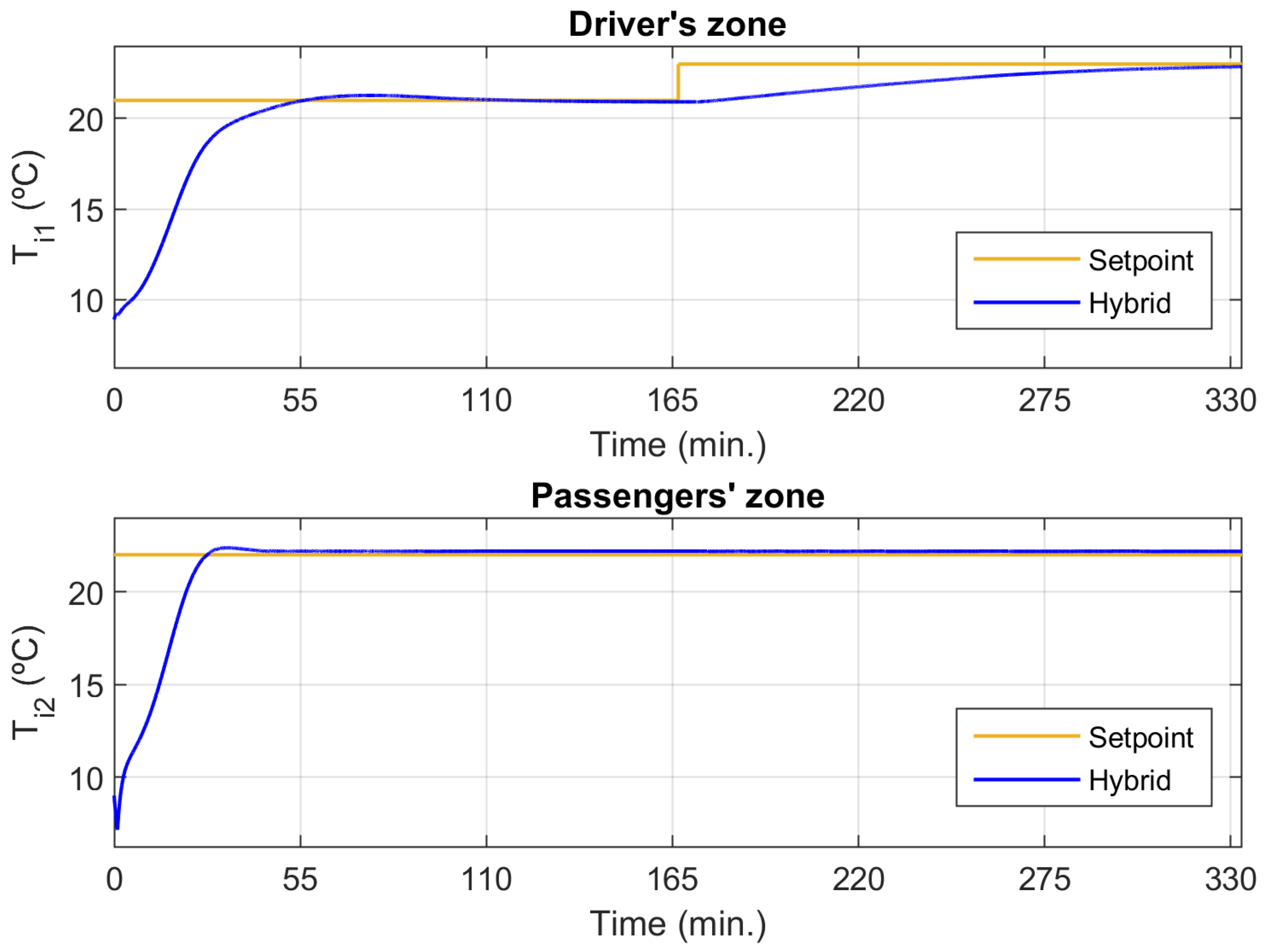


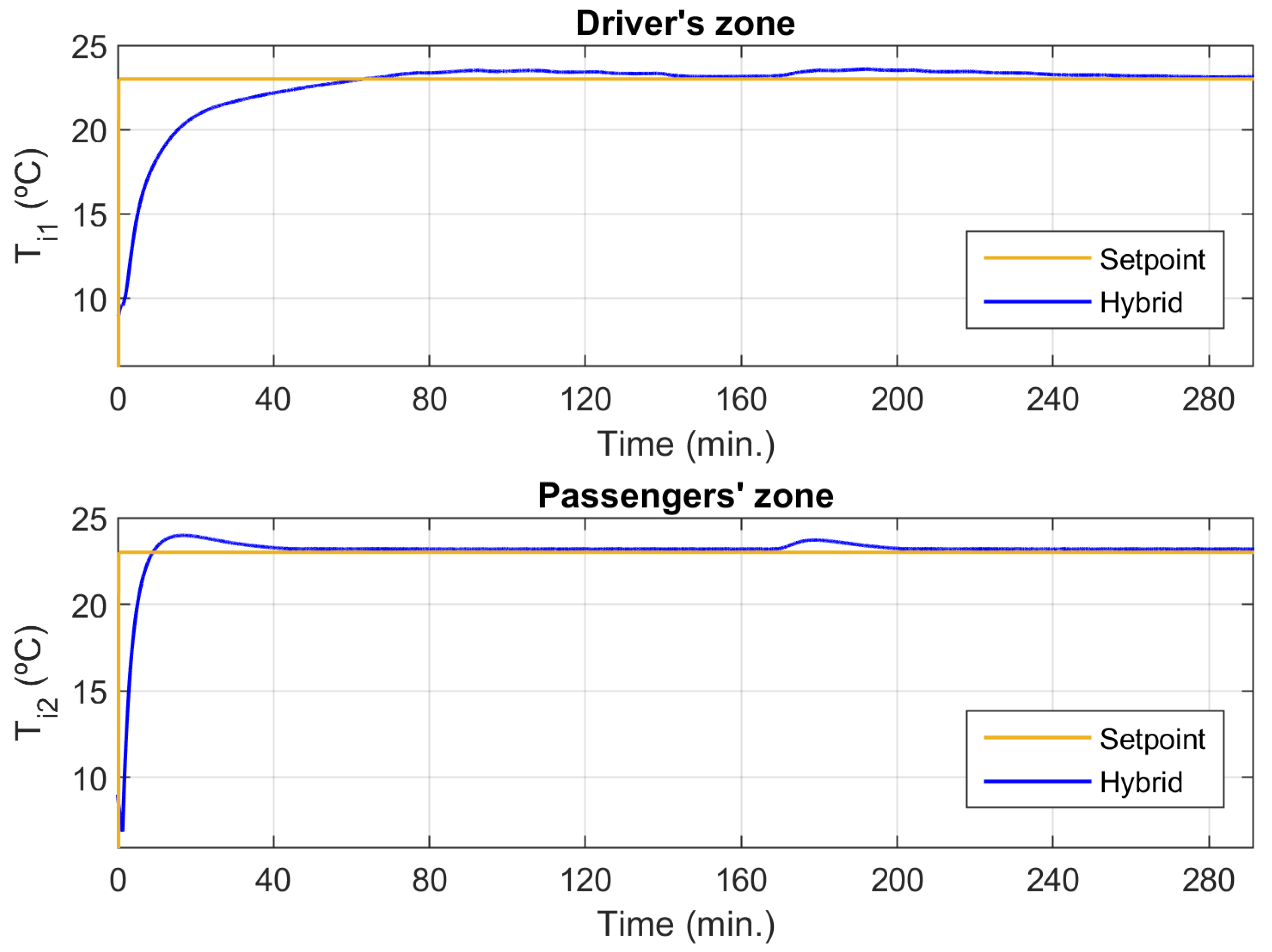
| Sensor | Brand/Model | Measured Variable | Measuring Range | Uncertainty |
|---|---|---|---|---|
| TT-1, TT-2, TT-3, and TT-4 | NXP/KTY 81/110 | Temperature | −55…+150 °C | ±1.27 °C |
| TI-1 | Wika/A43 | Temperature | 0…120 °C | ±2 °C |
| FT-1 | Endress+Hauser/Picomag | Flow rate | 0.05…25 L/min | ±0.8% |
| FT-2 | IFM/SA5000 | Flow rate | 0…100 m/s | ±7% |
| PI-1 | Mei/CL 1.6 | Pressure | 0…6 bar | ±0.4% |
| Parameter | Value |
|---|---|
| 12 m3 | |
| 0.0425 m3 | |
| 1.225 Kg·m−3 | |
| 2.5·103 Kg·m−3 | |
| 1005 J·Kg−1·K−1 | |
| 850 J·Kg−1·K−1 | |
| 1 | |
| 6.25 m2 | |
| 2.5 m2 | |
| 7 m2 | |
| 2 m2 | |
| 2 m2 |
| Parameter | Value |
|---|---|
| 100 m3 | |
| 0.325 m3 | |
| 5 m2 | |
| 30 m2 | |
| 30 m2 |
| Experiment Number | Initial Cabin Temperatures (°C) | Outside Temperature Range (°C) | Solar Irradiance (W/m2) | Experiment Time of Day | Weather Conditions | Number of Passengers |
|---|---|---|---|---|---|---|
| 1 | 5.2 / 5.7 | 0–10 | 0 | Night | Foggy | 5 |
| 2 | 13.8 / 17.1 | 7–16 | ≈200 | Noon | Sunny | 4 |
| 3 | 18.2 / 19.4 | 16.5–19 | ≈200 | Afternoon | Sunny | 4 |
| Experiment Number | Driver’s Zone | Passengers’ Zone | ||
|---|---|---|---|---|
| Max. Error (°C) | MAE (°C) | Max. Error (°C) | MAE (°C) | |
| 1 | 2.92 | 0.96 | 2.09 | 0.94 |
| 2 | 1.39 | 0.43 | 1.07 | 0.30 |
| 3 | 0.97 | 0.22 | 1.16 | 0.33 |
| Experiment Number | Driver’s Zone | Passengers’ Zone | ||
|---|---|---|---|---|
| Max. Error (°C) | MAE (°C) | Max. Error (°C) | MAE (°C) | |
| 1 | 2.35 | 0.57 | 2.39 | 0.46 |
| 2 | 1.58 | 0.28 | 0.91 | 0.17 |
| 3 | 1.13 | 0.35 | 1.13 | 0.21 |
Disclaimer/Publisher’s Note: The statements, opinions and data contained in all publications are solely those of the individual author(s) and contributor(s) and not of MDPI and/or the editor(s). MDPI and/or the editor(s) disclaim responsibility for any injury to people or property resulting from any ideas, methods, instructions or products referred to in the content. |
© 2023 by the authors. Licensee MDPI, Basel, Switzerland. This article is an open access article distributed under the terms and conditions of the Creative Commons Attribution (CC BY) license (https://creativecommons.org/licenses/by/4.0/).
Share and Cite
Delgado, M.L.; Jiménez-Hornero, J.E.; Vázquez, F. Design, Implementation and Validation of a Hardware-in-the-Loop Test Bench for Heating Systems in Conventional Coaches. Appl. Sci. 2023, 13, 2212. https://doi.org/10.3390/app13042212
Delgado ML, Jiménez-Hornero JE, Vázquez F. Design, Implementation and Validation of a Hardware-in-the-Loop Test Bench for Heating Systems in Conventional Coaches. Applied Sciences. 2023; 13(4):2212. https://doi.org/10.3390/app13042212
Chicago/Turabian StyleDelgado, María Luisa, Jorge E. Jiménez-Hornero, and Francisco Vázquez. 2023. "Design, Implementation and Validation of a Hardware-in-the-Loop Test Bench for Heating Systems in Conventional Coaches" Applied Sciences 13, no. 4: 2212. https://doi.org/10.3390/app13042212







